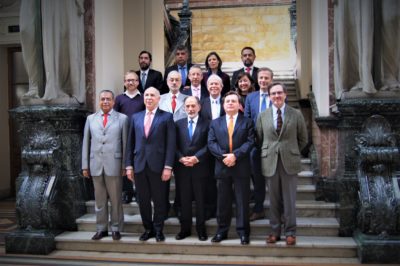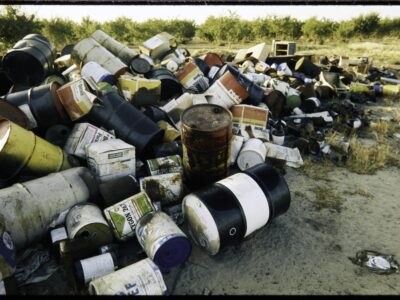Environmental Protection and the Rule of Law
A Report from the Second Inter-American Congress on Environmental Rule of Law

I am back from attending the Second Inter-American Congress on Environmental Rule of Law, hosted by the Supreme Court of Chile in Santiago and planned by the Organization of American States, UN Environment, IUCN World Commission on Environmental Law, and other partners.
For the past five years since the 2012 Rio+20 conference (20 years after the original Rio Earth Summit), stakeholders in the international environmental law community have been advancing discourse on law, justice, and governance in environmental matters—now under the umbrella of the “environmental rule of law.”
Participants in the IUCN World Environmental Law Congress in Rio de Janeiro held in 2016 (for which I served as the Program Coordinator) defined the concept in the World Declaration on Environmental Rule of Law:
The environmental rule of law is understood as the legal framework of procedural and substantive rights and obligations that incorporates the principles of ecologically sustainable development in the rule of law. Strengthening the environmental rule of law is the key to the protection, conservation, and restoration of environmental integrity. Without it, environmental governance and the enforcement of rights and obligations may be arbitrary, subjective, and unpredictable,
The environmental rule of law is premised on key governance elements including, but not limited to
a. Development, enactment, and implementation of clear, strict, enforceable, and effective laws, regulations, and policies that are efficiently administered through fair and inclusive processes to achieve the highest standards of environmental quality;
b. Respect for human rights, including the right to a safe, clean, healthy, and sustainable environment;
c. Measures to ensure effective compliance with laws, regulations, and policies, including adequate criminal, civil, and administrative enforcement, liability for environmental damage, and mechanisms for timely, impartial, and independent dispute resolution;
d. Effective rules on equal access to information, public participation in decision-making, and access to justice;
e. Environmental auditing and reporting, together with other effective accountability, transparency, ethics, integrity and anti-corruption mechanisms; and
f. Use of best-available scientific knowledge.
In Chile this week, we heard from high court judges, legislators, prosecutors, environment ministers and agency officials, academics, advocates, and other stakeholders about the advancement of the environmental rule of law in the Americas. Some highlights included remarks from Justice Sergio Muñoz of the Supreme Court of Chile, Chief Justice Ricardo Lorenzetti of the Supreme Court of Argentina, and Justice Antonio Benjamin of the High Court of Brazil, all of whom spoke about the need for using environmental law prospectively to prevent and take precautions against harm to the environment, rather than waiting to use the law as a reactive tool to address damage already done; and Luis Almagro, Secretary General of the Organization of American States, who spoke about applying environmental law to ensure that more rights are enjoyed by more people throughout the Western Hemisphere.

No double standard for pub. participation, access 2 info & justice: all must apply for projects affecting envt – CJ Lorenzetti of Argentina pic.twitter.com/Ix2AjYE5YT
— IUCN-WCEL (World Commission on Environmental Law) (@iucn_wcel) September 4, 2017
El derecho ambiental no debe ser una reacción al daño ambiental, sino la prevención – Min. Sergio Muñoz #DerechoAmbiental @PJudicialChile
— IUCN-WCEL (World Commission on Environmental Law) (@iucn_wcel) September 4, 2017
We also split into stakeholder working groups to discuss some key questions related to the environmental rule of law. I was asked to chair the working group of academics & NGOs, with the task of naming the most significant challenges to environmental rule of law in the Americas and listing concrete steps that our group can take to respond to these issues. Below is a summary of that discussion, with insightful ideas from colleagues from different countries around the region:
Challenges:
- Access to information. Despite technological and legal advances, there is still asymmetry between the information available to government decision-makers and private sector project developers vs. that which is available to the public or to communities affected by environmental degradation. Even where information is available, it may not be in a form that is useful to the public.
- Lack of trust. In many affected communities, there is a lack of confidence and trust in public institutions, private corporations, and/or international organizations.
- Backsliding. One of the goals in establishing the rule of law is promoting stability, reliability, and predictability in institutional decision-making. However, that stability has been threatened in many countries—including the United States—as both legislative bodies and executive officials walk back or weaken environmental regulations and requirements

Report from working groups during the Second Inter-American Congress on Environmental Rule of Law
Commitments and Contributions:
- As educators, we can make an effort to connect students to local communities. Academic institutions and civil society organizations can play an important role in improving access to information—and in translating legal information into what useful to the public.
- As legal professionals, we can think outside the law, pausing to consider what is happening in practice and whether the law needs reform in order to lead to more equitable outcomes
- Also, as professionals working on environmental issues, we can improve dialogue between law and science—in environmental law, there is a great need for people who can work across disciplines to help define policy objectives and to understand whether decisions taken are likely to help meet those objectives
The Congress served as a good opportunity for reflection on these ideas and as a reminder of the importance of applying sound scientific understanding of our environment to decision-making process in law and policy. As one of the speakers, Chile’s Comptroller General Jorge Bermúdez, put it: “we must understand the environment in order to make it a priority as a society.”

Reader Comments
One Reply to “Environmental Protection and the Rule of Law”
Comments are closed.







“The environmental rule of law is understood as the legal framework of procedural and substantive rights and obligations that incorporates the principles of ecologically sustainable development in the rule of law.” This appears to be a self-limiting definition that is restricted to sustainability and future development, which necessarily excludes non-sustainable past and current activities such as fossil fuel extraction, consumption and emissions..
“[A]ll of whom spoke about the need for using environmental law prospectively to prevent and take precautions against harm to the environment, rather than waiting to use the law as a reactive tool to address damage already done.” This appears to give a pass to, or grandfather, the fossil fuel, nuclear and other environmentally harmful industries.